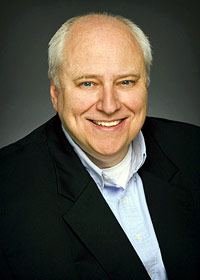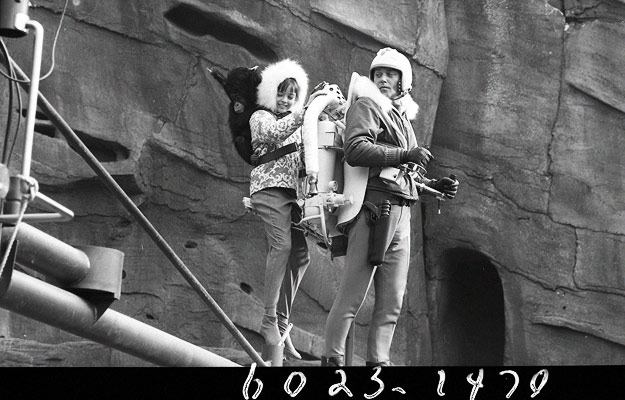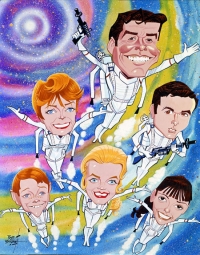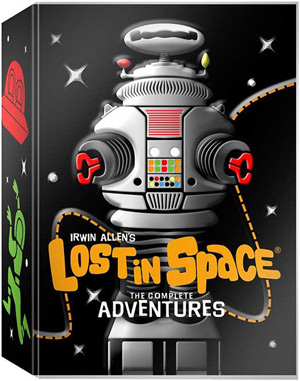 Kevin Burns heads up Prometheus Entertainment and has produced documentaries for several major motion pictures including The Godfather (The Godfather Legacy), Star Wars (Empire of Dreams and Star Wars: The Legacy Revealed), Cleopatra (Cleopatra: The Film That Changed Hollywood), Superman (Look, Up in the Sky!: The Amazing Story of Superman), and Valkyrie (The Plot to Kill Hitler). For E! Burns produced the television series The Girls Next Door and its spinoffs Kendra and Holly’s World, and he also produced the Biography series for A&E, for which he won two Emmy Awards.
Kevin Burns heads up Prometheus Entertainment and has produced documentaries for several major motion pictures including The Godfather (The Godfather Legacy), Star Wars (Empire of Dreams and Star Wars: The Legacy Revealed), Cleopatra (Cleopatra: The Film That Changed Hollywood), Superman (Look, Up in the Sky!: The Amazing Story of Superman), and Valkyrie (The Plot to Kill Hitler). For E! Burns produced the television series The Girls Next Door and its spinoffs Kendra and Holly’s World, and he also produced the Biography series for A&E, for which he won two Emmy Awards.
Michael Coate (The Digital Bits): In what way is Lost in Space worthy of celebration on its 50th anniversary?
Kevin Burns: Lost in Space holds a very important place in television history. It was the first, big-budget, prime-time science fiction/fantasy/adventure series for television. It was created and produced by the late, great Irwin Allen—later known as the “Master of Disaster” for his mega-hit movies, The Towering Inferno and The Poseidon Adventure—and had a top cast of well-known and respected actors (June Lockhart, Guy Williams, Jonathan Harris, Mark Goddard and Marta Kristen) and two of the very best child actors of the 1960s (Bill Mumy and Angela Cartwright). It ran for an impressive three years and 83 episodes on CBS (more episodes than Star Trek on NBC) and was usually the highest-rated show in its time period. (It usually beat Batman on ABC, believe it or not.) It also boasted top writers (like Carey Wilber, Norman Lessing and Alexander Singer), top directors (like Leo Penn) and great guest stars (like Kurt Russell, Warren Oates and Strother Martin). It had ultra-cool theme songs and music by John Williams, art direction by William Creber (Planet of the Apes), make-up by John Chambers (Planet of the Apes) and an iconic Robot designed by Robert Kinoshita (Forbidden Planet). It had space ships, space “pods,” chariot land rovers and even rocket belts. It had alien chimps (Debbie the Bloop), one-eyed cyclopses, and even talking carrots. But most of all, it was a family show—fun, visual and highly imaginative. As we used to say in the 60s…it was “groovy.”

Coate: Can you recall when you first saw the show?
Burns: I was ten years old when the show premiered in 1965. I missed the first episode and I never forgave myself for that (especially since everyone at school was talking about it the next day). They never re-ran it on CBS and I never did see it until the series ran in syndication some years later. For me, it has to be one of the top ten “first episodes” of all time. I did watch the second episode, however (The Derelict), and I thought it was incredible. I was hooked from that point on. Later, I found out that the father of one of my best friends was one of the writers of the series (Carey Wilber) and that made it even more special. I even made my own Lost in Space comic books—using Mort Drucker’s caricatures from the Mad magazine spoof (Loused Up in Space) as my photo references. I guess you could say I became obsessed.

Coate: Where do you think Lost in Space ranks among sci-fi and fantasy shows?
Burns: Even after 50 years, Lost in Space would certainly have to rank in the top ten. Now, I know there are many who think the stories were often too silly and that the special effects were a bit “cheesy.” (Those are the people for whom Star Trek and The Twilight Zone represent the gold standard.) But Lost in Space was deliberately designed to be more of a fantasy adventure series than one that was “straight” science fiction. CBS scheduled the show at 7:30pm on Wednesday nights—when children controlled the dial on what was the family’s only B&W TV set. It was CBS that pushed the Dr. Smith and Robot B9 characters more into the center of the action. They didn’t want anything that would be too intense or scary. It must have worked because Lost in Space has been airing all over the world and non-stop for 50 years.

Coate: Which do you believe are the standout episodes?
Burns: Like many fans, I prefer the First Season episodes. There were 29 of them and at least 15 of them are incredible. The first five (which were re-cut and expanded from the original un-aired pilot which Irwin Allen directed) are the best. They’re like a five-hour movie. They’re also played very “straight” and are very dramatic. After that my list would include, Welcome Stranger (with Warren Oates), My Friend, Mr. Nobody, Invaders from the Fifth Dimension, War of the Robots, Wish upon a Star, The Keeper (with Michael Rennie), Return from Outer Space, and Follow the Leader. In Season Two, Blast Off in Outer Space is among the best. This is the season where the Smith-Will-Robot antics really take over—and some of the episodes are, admittedly, hard to get through (for example, The Questing Beast). Still, they’re a lot of fun and the art direction is incredible. (Irwin LOVED orange, in case you couldn’t tell!) Of course, some people HATE the over-the-top performance by Jonathan Harris in this season, but I challenge those people to take your eyes off him. Jonathan as Dr. Smith is one of the most original and memorable characters in the history of television—ranking right up there with Barney Fife, Herman Munster, Gilligan and the Fonz. As for Season Three, there was much more a balance between serious family drama, sci-fi action-adventure and wild comedic fantasy. There were many fine episodes that year—particularly Visit to a Hostile Planet and The Anti-Matter Man. I also think The Promised Planet and The Great Vegetable Rebellion are a “hoot” (as June Lockhart would say). Much more entertaining than you’d think—given their wild subject matter (psychedelic space hippies and talking carrots).

Coate: Which are the ideal episodes to introduce to someone who has never seen the show?
Burns: Definitely, the first five episodes of Season One.
Coate: What were the challenges in bringing the show to Blu-ray Disc?
Burns: When the Lost in Space DVD set came out in 2004, I was heartsick. The color and quality were pretty good for regular color TVs, but on a big screen, it looked blurry and washed out. I was working as a television producer at Fox at the time and asked why the studio had chosen not to remaster it beforehand. The answer was simple: money. That, and the fact that Fox was only the distributor. The Irwin Allen Trust (controlled by Irwin’s widow, Sheila) controlled the negatives. About five years ago, I went to Sheila and asked her if she and her two business partners in the series would allow me to divert some of the revenues they were receiving and use them to remaster all 83 one-hour episodes, along with the two versions that existed of the original unaired pilot. It was not a simple request, since the best estimates we received for the HD transfers were just under one million dollars! Luckily, Sheila gave her blessing—especially after we showed her a side-by-side test of an episode in Standard Def versus one on Blu-ray. The masters were then called up from Fox’s underground vaults (fine grain master positives for B&W episodes, CRIs for the color ones) and then sent to HTV/Illuminate for restoration and mastering of the picture elements. The magnetic sound elements were tracked down and restored at SSI in Hollywood. Three masters were then made for each episode. The first was a straight reverse anamorphic transfer from top-to-tail—capturing every detail of every 35mm frame. These masters would include SMPTE leaders, commercials (if any), bumpers, CBS logos, etc. From this master element, both a “flat” (1.37:1) and a “wide” (1.78:1) version were made. All of the episodes on the Blu-ray are in 1.37:1 with a mono mix. However, the Special Features disc features a bonus/alternate version of Episode #1501 (Condemned of Space) in 1.78:1 and with a 5.1 stereo mix. (It’s awesome.) I know that Fox would like to distribute this widescreen version to television from now on—but there could be a Blu-ray/DVD release in the future.

Although most of the original elements were in surprisingly fine shape, there were several challenges. One of these, of course, involved scratches—but many of these were actually in the original camera negatives when the series was photographed in the 1960s. Where we could, we removed them. The biggest challenges often involved sound. As we wanted to use magnetic elements (which were only ever in mono, by the way), we tracked them down only to find the original 35mm mixed mag materials had been destroyed years ago. Luckily, 1/4” and 1” protection masters had been made—but some of these were missing the original 20th Century Fox Television fanfares at the end (which we wanted to restore) or had a few noticeable distortions (which we fixed). Worst of all was in the cliffhanger portion of the Second Season episode, The Dream Monster. When the cliffhanger began (which would lead into The Golden Man episode), we had 20 seconds of picture of a scene where Penny and Dr. Smith are picking flowers—but no audio. Suddenly, the audio came on while Dr. Smith was in mid-sentence. When we checked both the DVDs and the 1” analog masters created in the 1980s, we found that the scene began as an abrupt “fade-in” while Dr. Smith was talking. The 20 seconds of picture had been deleted. It was only after I went back to a 16mm print I had of the episode that I located the missing audio! Somehow, in the 1980s, someone had made a huge mistake in transferring the 35mm mag tracks. Needless to say, we restored the sequence—along with all the Season Three “Next Week” trailers. To the best of our knowledge, there isn’t so much as a frame missing on the Blu-ray release.

Coate: What is the legacy of Lost in Space?
Burns: The fact is, if it weren’t for Lost in Space, there wouldn’t have been a Star Trek. If Lost in Space had flopped, NBC would have never picked it up. It was the first. It set the bar. There’s been nothing like it—before or since. It is the granddaddy of science-fiction on television and has been seen in more than 50 countries and translated into more than 30 languages. Let’s face it, after 50 years we’re still talking about it—and that’s more than you can say about most things.
Coate: Thank you, Kevin, for sharing your thoughts on Lost in Space on the occasion of its 50th anniversary and its much-anticipated release on Blu-ray.

---
- Michael Coate




